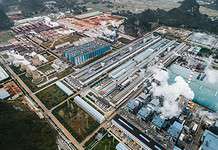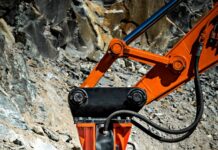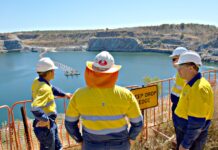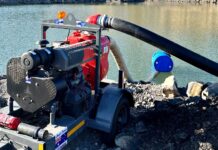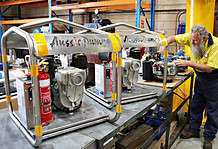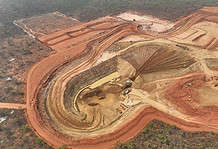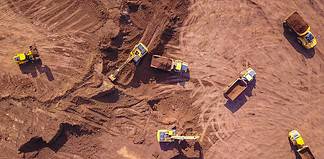The Hellyer gold mine near Beaconsfield in Tasmania has been revived by NQ Minerals, which is mining a waste tailings resource predicted to generate $706m over a 10-year mine life. The company ramped up to production late in 2018 after acquiring the mine and its assets in 2017, and is looking for the next big project.
NORTHERN Queensland Minerals (NQ Minerals) will see out its inaugural year of production at its flagship, 100pc-owned Hellyer mine on a high note.
The company acquired Hellyer gold mine, an 8mt reserve of high-grade tailings, in 2017, and after a relatively short ramp-up period, started production late in 2018 dredging the tailings for lead, zinc and precious metals concentrates.
The project has a 10-year mine life and a projected revenue of US$706m, with an EBITDA of US$28m.
The existing infrastructure includes a fully-operable 1.6mtpa fully-automated flotation plant, an Undercover concentrate loading station, existing port concentrate housing, handling and loading facilities and an existing tailings dredge.
During 2019, the company contracted a second, high-capacity mining dredge for its operations.
The 100tph dredge will be on site by the year-end and complEment the existing mining dredge at Hellyer, Seabird III, which is currently feeding 100tph to the processing plant.
NQ Minerals said that the second dredge will provide opportunities for increased tonnage through the plant.
It said it would “reduce risk of a major stoppage of feed to the plant, continuity and consistency of feed tonnage and grade to the plant, options in relation to tails transfer logistics, backup operation during maintenance to Seabird III”, which to date has amounted to about 22 hours per month.
A record quarter
The September quarter saw the company improve plant performance to achieve record monthly production with the trend continuing through October.
The company said that during this period, production emphasis was placed on concentrate grades and metallurgical recoveries in the lead and zinc circuits.
“The improvements in metallurgical recoveries from August to September increased from 36.5pc to 45.35pc in the lead circuit and from 33.7pc to 42pc in the zinc circuit,” it said.
“These recoveries compare with life of mine projections of 47pc for lead and 38pc for zinc.”
The lead recoveries were 41.4pc, and zinc was 48.3pc.
Zinc recovery was lower in the quarter compared to Q2, mainly as a result of the lower zinc grades as the zone being dredged, and lower pyrite production was a result of the process changes that required a temporary halt in pyrite production, which the company said had been resolved.
Outgoing NQ Minerals chair, Brian Stockbridge, said that there was a continued positive trend in milled tonnes and metallurgical recoveries at Hellyer.
“The company achieved record production in September, and we continue to realise improvements in the current month,” he said.
“With operations now stabilised, we are evaluating multiple opportunities for further value creation.”
The company continued its winning streak in November, posting $2.44m revenue from $5.64m.
It mined 73,358t and processed 73,532t of tailings, producing 2780t lead concentrates and 1426t zinc concentrates.
NQ Minerals appoints new chair
Mr Stockbridge stepped down as chair of the company in November, with the company appointing David Lenigas in his place.
Mr Lenigas has a long history of directorship and has chaired many boards, including his most recent position at Future Farm Technologies as non-executive chairman in 2019, and Hampton Bay Capital as director.
Mr Lenigas said that he was excited by the prospect of improving the output of the mine going forward.
“This output is ahead of initial project estimates and resulted in revenue for the month of $5.25m with an operating profit of $1.6m,” he said.
“For the 10 months to October 31, 2019, the project has generated unaudited turnover of $43.7m with an operating profit of $9.1m.
“The dedication of management and operations teams has achieved remarkable success at Hellyer over the past year and we all expect to see even further improvements in operational performance over the coming months from this long-life mining operation.”
Forecastint future growth potential for NQ Minerals, Mr Lenigas said
the company had a fantastic operation at Hellyer, and significant efforts are being made to improve profitability and further extend the operation’s life of mine.
“I am also particularly keen to assist the board and management with their initiatives towards the development of long-life nickel operations in Tasmania, through their recently announced strategic investment into Tasmania Energy Metals,” he said.
“New JORC 2014 resources for the Nickel Project will be available for release over the coming weeks.
“And finally, I join the entire board, management, staff, off-take partners, shareholders, bond and debt providers of NQ Minerals in sincerely thanking Brian Stockbridge for his tremendous efforts with chairing the company since it was formed some four years ago.
“His achievements in assisting to make the Hellyer operations the success we see today, are a true credit to him and a testament to his perseverance and belief in project.”
Barnes Hill, Scotts Hill and Mt Vulcan
The company is looking to expand its operations in Tasmania, launching a pre-feasibility study into the Barnes Hill nickel project, about 120km from Hellyer, and new resources at the Scotts Hill and Mt Vulcan deposits.
The Barnes Hill project has an estimated 14.3mt grading at 0.72pc nickel and 0.05pc cobalt.
The pre-feasibility study is targeting throughput of about 630,000tpa nickel ore, and 240,000tpa of pyrite/precious metal concentrate from Hellyer.
Scotts Hill and Mt Vulcan deposits, or the Scotts-Vulcan, are lateric nickel deposits located 2km from Tasmania Energy Metals (TEM) 100pc-owned Barnes Hill North deposit.
Mr Lenigas said that he was pleased at the progress being made at the projects.
“The new Mineral Resource estimates for TEM’s Scotts Hill and Mt Vulcan deposits more than doubles their available nickel and cobalt resource in the local areas surrounding our Hellyer operations, pushing resource estimates from 6.6Mt to 14.3Mt,” he said.
“TEM is working towards a feasibility study that targets more than 20 years of plant feed for a planned operation in the Bell Bay area.
“NQ’s investment in this project has the potential to materially enhance the economic returns on Hellyer’s gold and silver reserves and add nickel and cobalt to the company’s suite of metals available for global sales from our Tasmanian operations.”




